Abstract
A mu-capture enzyme-linked immunosorbent assay (ELISA) for detection of serum immunoglobulin M (IgM) antibodies to Borrelia burgdorferi by using biotinylated purified B. burgdorferi flagella was developed. The diagnostic performance of the mu-capture ELISA was compared with that of a conventional indirect ELISA. Sera from untreated patients with erythema migrans (n = 50), neuroborreliosis (n = 100), and acrodermatitis chronica atrophicans (ACA; n = 48) were investigated. The cutoff of the ELISAs was adjusted to a diagnostic specificity of 98% on the basis of examination of 200 serum specimens from healthy controls. The mu-capture ELISA increased the diagnostic sensitivity in patients with erythema migrans from 32 to 48% (P less than 0.01) and in patients with neuroborreliosis from 37 to 57% (P less than 0.001). Because of an increased signal/noise ratio, the mu-capture ELISA yielded a significantly better quantitative discrimination of individual positive measurements from the cutoff (P less than 0.001). The increased signal/noise ratio was most likely a consequence of the elimination of IgG competition for the test antigen. This may also explain why 12% of patients with ACA showed significantly increased specific IgM levels only by the mu-capture ELISA. Of patients with ACA, 27% had IgM rheumatoid factor. The mu-capture principle with a directly labeled antigen showed no interference with IgM rheumatoid factor, in contrast to the indirect ELISA. The high diagnostic performance and ease of this three-step mu-capture ELISA make it suitable for routine anti-B. burgdorferi IgM serodiagnosis.
Full text
PDF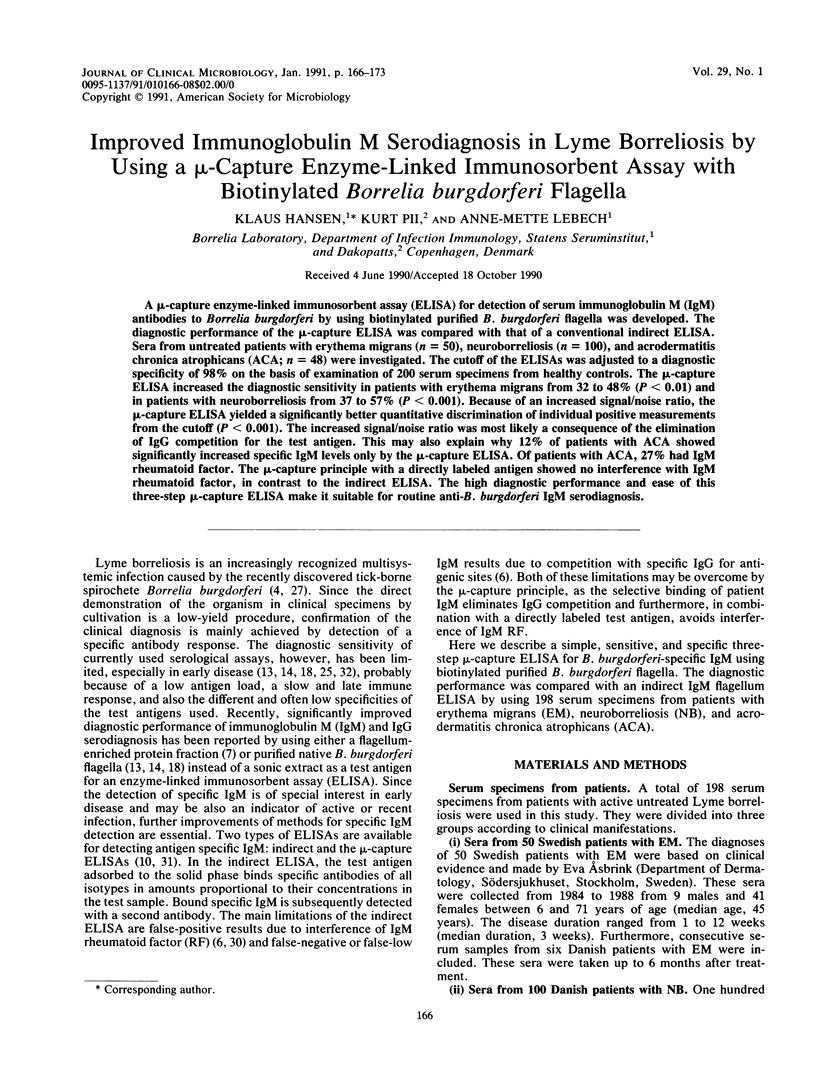
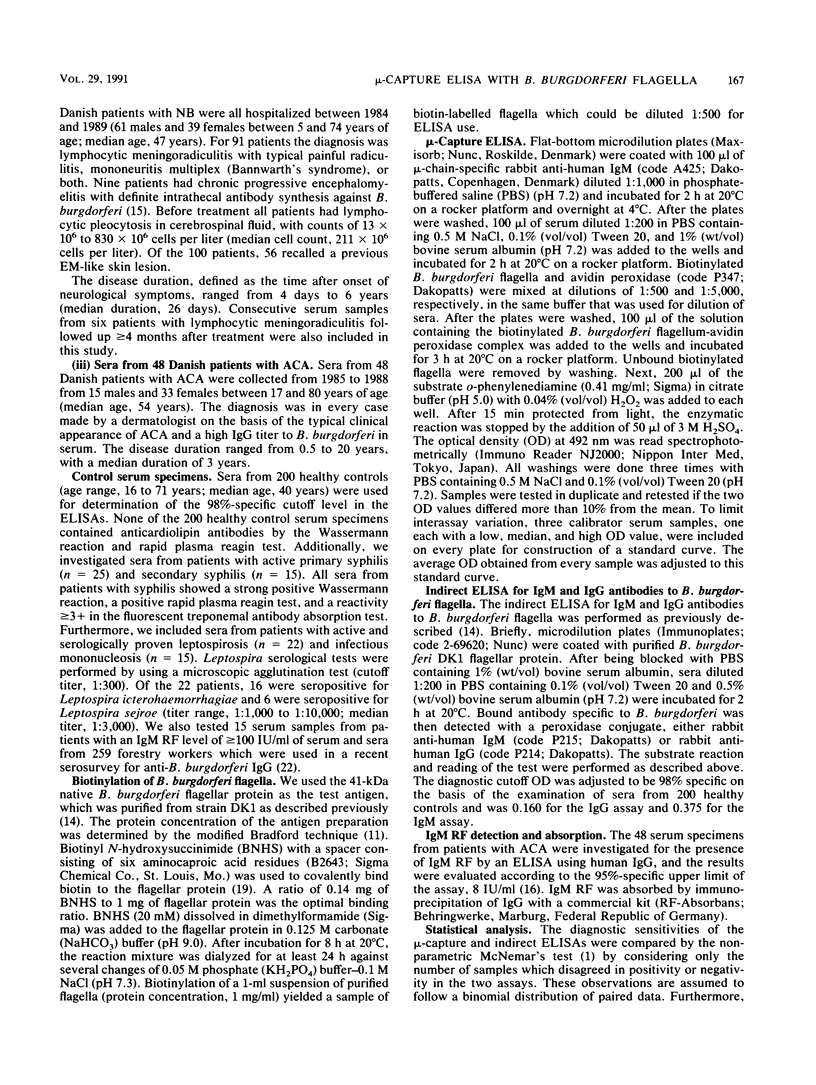

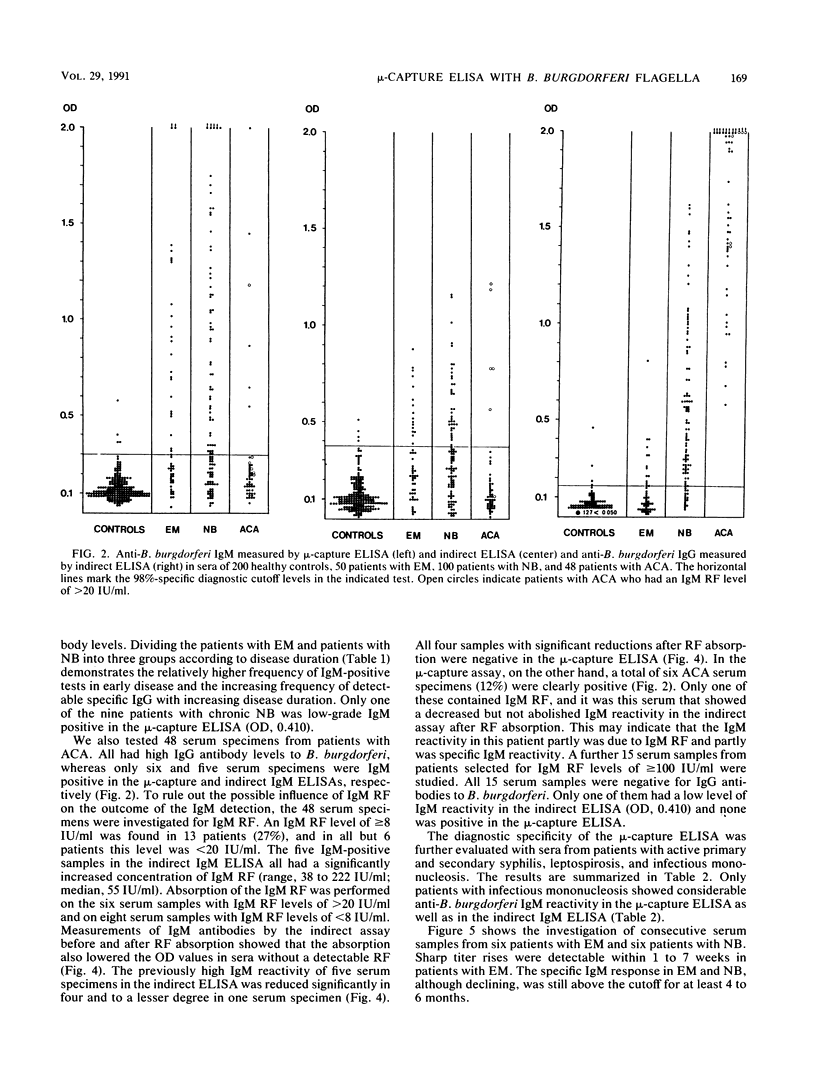
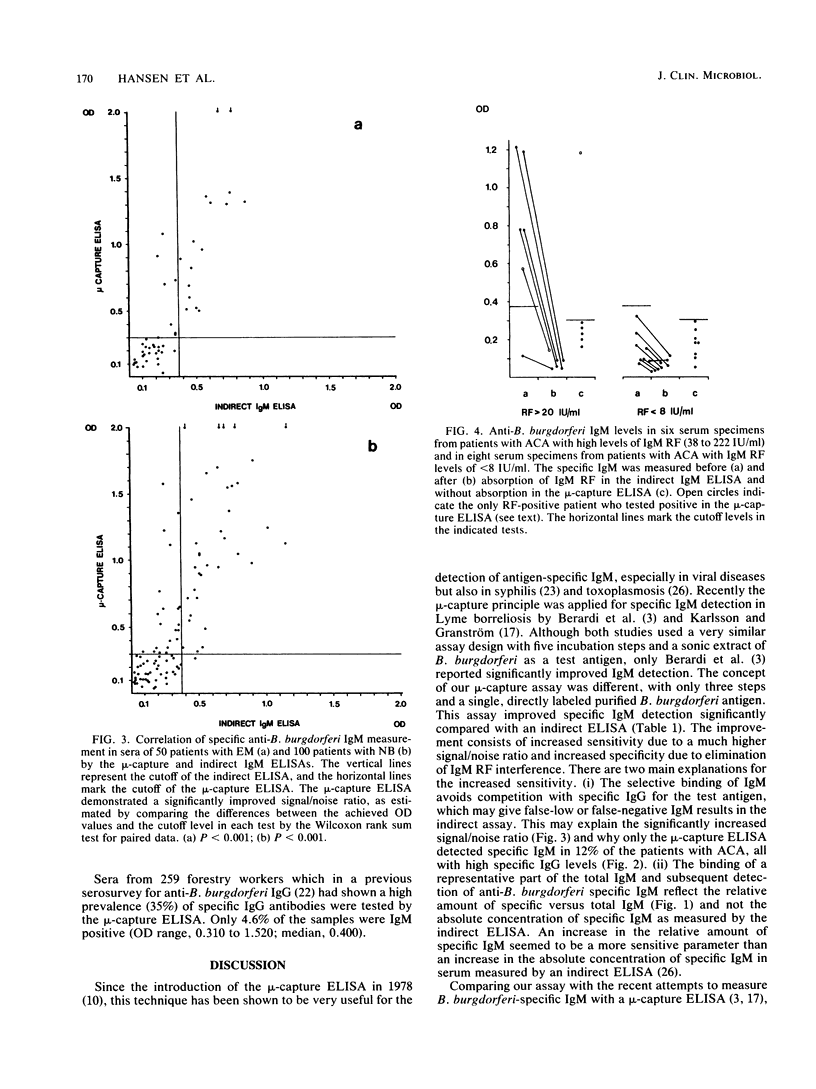

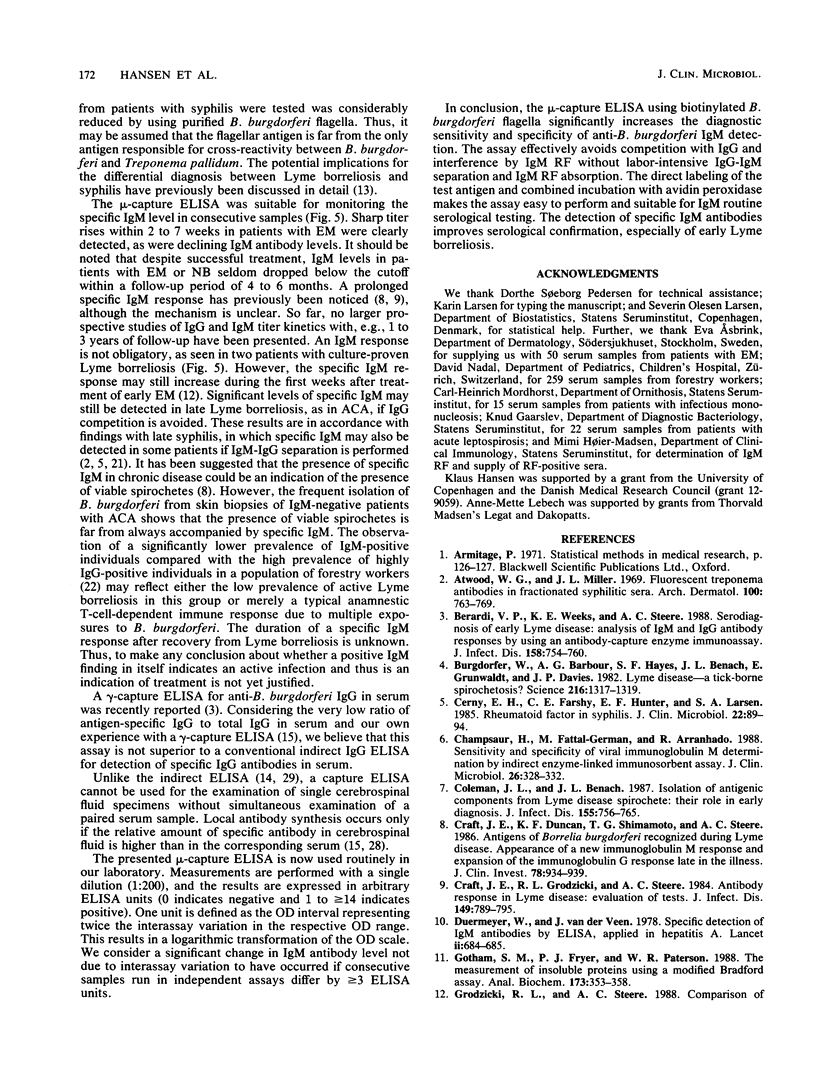
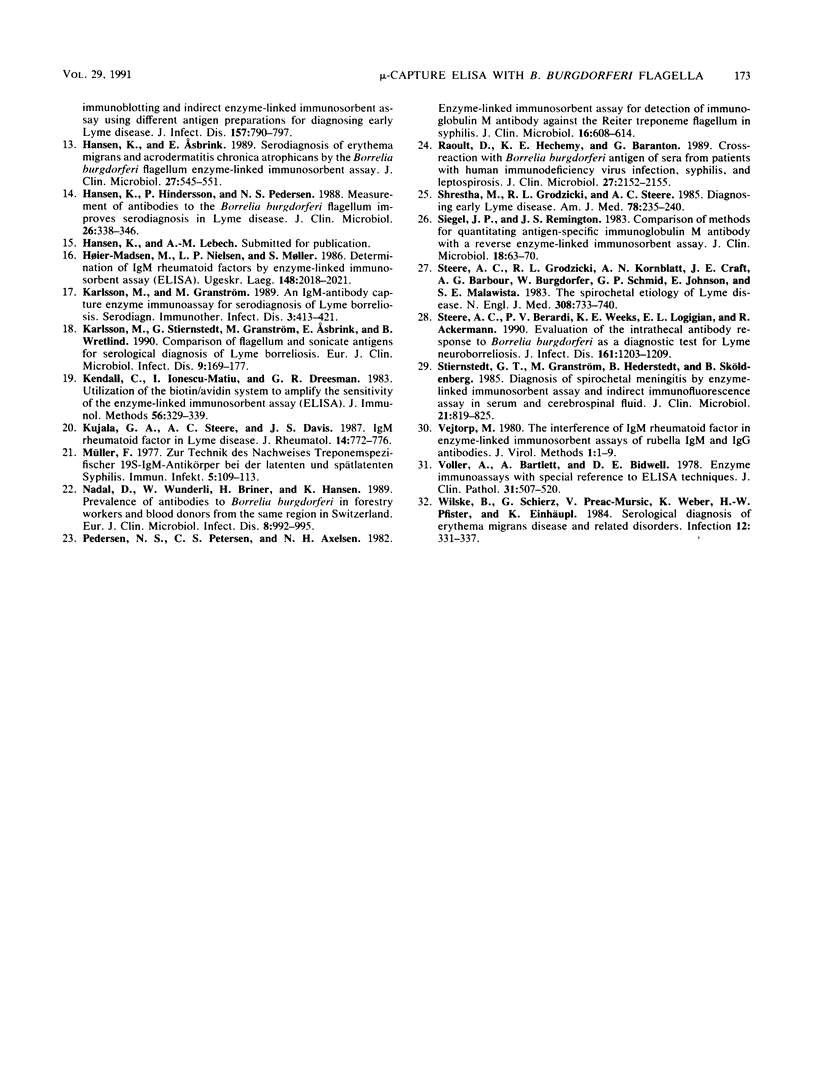
Selected References
These references are in PubMed. This may not be the complete list of references from this article.
- Atwood W. G., Miller J. L. Fluorescent treponemal antibodies in fractionated syphilitic sera. The immunoglobulin class. Arch Dermatol. 1969 Dec;100(6):763–769. [PubMed] [Google Scholar]
- Berardi V. P., Weeks K. E., Steere A. C. Serodiagnosis of early Lyme disease: analysis of IgM and IgG antibody responses by using an antibody-capture enzyme immunoassay. J Infect Dis. 1988 Oct;158(4):754–760. doi: 10.1093/infdis/158.4.754. [DOI] [PubMed] [Google Scholar]
- Burgdorfer W., Barbour A. G., Hayes S. F., Benach J. L., Grunwaldt E., Davis J. P. Lyme disease-a tick-borne spirochetosis? Science. 1982 Jun 18;216(4552):1317–1319. doi: 10.1126/science.7043737. [DOI] [PubMed] [Google Scholar]
- Cerny E. H., Farshy C. E., Hunter E. F., Larsen S. A. Rheumatoid factor in syphilis. J Clin Microbiol. 1985 Jul;22(1):89–94. doi: 10.1128/jcm.22.1.89-94.1985. [DOI] [PMC free article] [PubMed] [Google Scholar]
- Champsaur H., Fattal-German M., Arranhado R. Sensitivity and specificity of viral immunoglobulin M determination by indirect enzyme-linked immunosorbent assay. J Clin Microbiol. 1988 Feb;26(2):328–332. doi: 10.1128/jcm.26.2.328-332.1988. [DOI] [PMC free article] [PubMed] [Google Scholar]
- Coleman J. L., Benach J. L. Isolation of antigenic components from the Lyme disease spirochete: their role in early diagnosis. J Infect Dis. 1987 Apr;155(4):756–765. doi: 10.1093/infdis/155.4.756. [DOI] [PubMed] [Google Scholar]
- Craft J. E., Fischer D. K., Shimamoto G. T., Steere A. C. Antigens of Borrelia burgdorferi recognized during Lyme disease. Appearance of a new immunoglobulin M response and expansion of the immunoglobulin G response late in the illness. J Clin Invest. 1986 Oct;78(4):934–939. doi: 10.1172/JCI112683. [DOI] [PMC free article] [PubMed] [Google Scholar]
- Craft J. E., Grodzicki R. L., Steere A. C. Antibody response in Lyme disease: evaluation of diagnostic tests. J Infect Dis. 1984 May;149(5):789–795. doi: 10.1093/infdis/149.5.789. [DOI] [PubMed] [Google Scholar]
- Duermeyer W., van der Veen J. Specific detection of IgM-antibodies by ELISA, applied in hepatitis-A. Lancet. 1978 Sep 23;2(8091):684–685. doi: 10.1016/s0140-6736(78)92802-7. [DOI] [PubMed] [Google Scholar]
- Gotham S. M., Fryer P. J., Paterson W. R. The measurement of insoluble proteins using a modified Bradford assay. Anal Biochem. 1988 Sep;173(2):353–358. doi: 10.1016/0003-2697(88)90199-6. [DOI] [PubMed] [Google Scholar]
- Grodzicki R. L., Steere A. C. Comparison of immunoblotting and indirect enzyme-linked immunosorbent assay using different antigen preparations for diagnosing early Lyme disease. J Infect Dis. 1988 Apr;157(4):790–797. doi: 10.1093/infdis/157.4.790. [DOI] [PubMed] [Google Scholar]
- Hansen K., Asbrink E. Serodiagnosis of erythema migrans and acrodermatitis chronica atrophicans by the Borrelia burgdorferi flagellum enzyme-linked immunosorbent assay. J Clin Microbiol. 1989 Mar;27(3):545–551. doi: 10.1128/jcm.27.3.545-551.1989. [DOI] [PMC free article] [PubMed] [Google Scholar]
- Hansen K., Hindersson P., Pedersen N. S. Measurement of antibodies to the Borrelia burgdorferi flagellum improves serodiagnosis in Lyme disease. J Clin Microbiol. 1988 Feb;26(2):338–346. doi: 10.1128/jcm.26.2.338-346.1988. [DOI] [PMC free article] [PubMed] [Google Scholar]
- Høier-Madsen M., Nielsen L. P., Møller S. Bestemmelse af IgM-rheumafaktorer ved enzyme-linked immunosorbent assay (ELISA). Ugeskr Laeger. 1986 Aug 4;148(32):2018–2021. [PubMed] [Google Scholar]
- Karlsson M., Stiernstedt G., Granström M., Asbrink E., Wretlind B. Comparison of flagellum and sonicate antigens for serological diagnosis of Lyme borreliosis. Eur J Clin Microbiol Infect Dis. 1990 Mar;9(3):169–177. doi: 10.1007/BF01963833. [DOI] [PubMed] [Google Scholar]
- Kendall C., Ionescu-Matiu I., Dreesman G. R. Utilization of the biotin/avidin system to amplify the sensitivity of the enzyme-linked immunosorbent assay (ELISA). J Immunol Methods. 1983 Feb 11;56(3):329–339. doi: 10.1016/s0022-1759(83)80022-2. [DOI] [PubMed] [Google Scholar]
- Kujala G. A., Steere A. C., Davis J. S., 4th IgM rheumatoid factor in Lyme disease: correlation with disease activity, total serum IgM, and IgM antibody to Borrelia burgdorferi. J Rheumatol. 1987 Aug;14(4):772–776. [PubMed] [Google Scholar]
- Müller F. Zur Technik des Nachweises treponemenspezifischer 19S-IgM-Antikörper bei der latenten und spätlatenten Syphilis. Immun Infekt. 1977 Jun;5(3):109–113. [PubMed] [Google Scholar]
- Nadal D., Wunderli W., Briner H., Hansen K. Prevalence of antibodies to Borrelia burgdorferi in forestry workers and blood donors from the same region in Switzerland. Eur J Clin Microbiol Infect Dis. 1989 Nov;8(11):992–995. doi: 10.1007/BF01967572. [DOI] [PubMed] [Google Scholar]
- Pedersen N. S., Petersen C. S., Axelsen N. H. Enzyme-linked immunosorbent assay for detection of immunoglobulin M antibody against the Reiter treponeme flagellum in syphilis. J Clin Microbiol. 1982 Oct;16(4):608–614. doi: 10.1128/jcm.16.4.608-614.1982. [DOI] [PMC free article] [PubMed] [Google Scholar]
- Raoult D., Hechemy K. E., Baranton G. Cross-reaction with Borrelia burgdorferi antigen of sera from patients with human immunodeficiency virus infection, syphilis, and leptospirosis. J Clin Microbiol. 1989 Oct;27(10):2152–2155. doi: 10.1128/jcm.27.10.2152-2155.1989. [DOI] [PMC free article] [PubMed] [Google Scholar]
- Shrestha M., Grodzicki R. L., Steere A. C. Diagnosing early Lyme disease. Am J Med. 1985 Feb;78(2):235–240. doi: 10.1016/0002-9343(85)90432-2. [DOI] [PubMed] [Google Scholar]
- Siegel J. P., Remington J. S. Comparison of methods for quantitating antigen-specific immunoglobulin M antibody with a reverse enzyme-linked immunosorbent assay. J Clin Microbiol. 1983 Jul;18(1):63–70. doi: 10.1128/jcm.18.1.63-70.1983. [DOI] [PMC free article] [PubMed] [Google Scholar]
- Steere A. C., Berardi V. P., Weeks K. E., Logigian E. L., Ackermann R. Evaluation of the intrathecal antibody response to Borrelia burgdorferi as a diagnostic test for Lyme neuroborreliosis. J Infect Dis. 1990 Jun;161(6):1203–1209. doi: 10.1093/infdis/161.6.1203. [DOI] [PubMed] [Google Scholar]
- Steere A. C., Grodzicki R. L., Kornblatt A. N., Craft J. E., Barbour A. G., Burgdorfer W., Schmid G. P., Johnson E., Malawista S. E. The spirochetal etiology of Lyme disease. N Engl J Med. 1983 Mar 31;308(13):733–740. doi: 10.1056/NEJM198303313081301. [DOI] [PubMed] [Google Scholar]
- Stiernstedt G. T., Granström M., Hederstedt B., Sköldenberg B. Diagnosis of spirochetal meningitis by enzyme-linked immunosorbent assay and indirect immunofluorescence assay in serum and cerebrospinal fluid. J Clin Microbiol. 1985 May;21(5):819–825. doi: 10.1128/jcm.21.5.819-825.1985. [DOI] [PMC free article] [PubMed] [Google Scholar]
- Voller A., Bartlett A., Bidwell D. E. Enzyme immunoassays with special reference to ELISA techniques. J Clin Pathol. 1978 Jun;31(6):507–520. doi: 10.1136/jcp.31.6.507. [DOI] [PMC free article] [PubMed] [Google Scholar]
- Wilske B., Schierz G., Preac-Mursic V., Weber K., Pfister H. W., Einhäupl K. Serological diagnosis of erythema migrans disease and related disorders. Infection. 1984 Sep-Oct;12(5):331–337. doi: 10.1007/BF01651147. [DOI] [PubMed] [Google Scholar]


